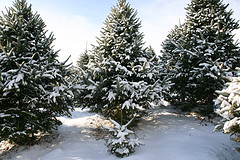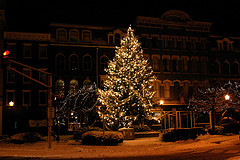What Would Christmas be Without a Live Tree?
By: Amos S. Eno
Posted on:12/20/2010 Updated:12/07/2011It’s a family affair at the North Parish Christmas Tree Farm in central Maine.
“Strictly balsam fir! The fresh-cut tree smell that people associate with Christmas is balsam.”
Mark Rabon is describing the trees on offer at the North Parish Christmas Tree Farm, which he bought five years ago with his wife of 20 years and their two kids. The 70-acre farm with 8 acres of balsam fir plantation is located in Turner, Maine , north of Lewiston in the foothills of the western mountains. When he bought it, it had already been an established tree farm for decades.
, north of Lewiston in the foothills of the western mountains. When he bought it, it had already been an established tree farm for decades.
“We used to come here years ago,” Mark says, “and now we love having families come through each year. It’s amazing to see the smiles on their faces. Everyone is usually in a good mood, except for the occasional ‘grinch’ upset because his dog has to stay in the car. We like helping to keep it a tradition.”
When the previous owners decided to get out of the business, they did not intend to sell it as a Christmas tree farm, so virtually half of their 8-acre inventory had been cut without replanting. That’s why, in the first few years Mark’s plantations were half empty.
“We’ve put 7,000 to 8000 trees in the ground since we bought it,” Mark says proudly. Because central Maine does not have the root rot issues prevalent in other parts of the country, Mark can simply plant a seedling next to each stump.
Choose and Cut
Though planted in rows, his trees are all sizes because he runs a “choose and cut operation.” When people arrive, he hands them a bow saw, and they go out in search of their own tree. (Family Farm Insurance is the only company Mark could find willing to insure an operation that hands out sharp instruments.)
“People come in droves. Sometimes there will be a line of people waiting to go out and cut their tree using one of my 30 saws. My wife, Jean, makes wreaths and ‘kissing balls‘ made from balsam fir tips. One year we had a friend’s string and woodwind band play in the barn. Next year, we might serve hot chocolate.”
Mark chuckles recalling a second-year customer who showed up and spent 45 minutes recounting his trials and tribulations capturing a family of stowaway mice that had ridden into his house on the previous year’s Christmas tree. Many times he’s had to help customers manhandle their 15- to 18-foot trees from the fields and through the baler for transport home, usually with the help of a winch.
The Passion of Christmas . . . Trees
How is it going? “It’s going well,” Mark says. Depending on his inventory, he can sell up to 1000 trees a year, at $30 per tree. “You don’t get rich growing Christmas trees. It’s very difficult to get started because you have seven years of sunk costs in the form of weed control, fertilizing, and pruning before you can turn a dime. It was a blessing to be able to buy a place that had already been established.”
“It’s a passion,” Mark continues, “for the trees, for the process of growing them, and for the celebration of the reason for Christmas. We’re now able to cover our costs and put some aside, but I’m not about to give up my other full-time job as co-owner/manager of running Integrated Forest Management.
“Half of the reason for owning the farm is for the outdoor lifestyle. My kids, Thomas and Corinne, are now 16 and 12. Growing up on the farm means a lot of work, it’s a family affair. We wanted to help our children to grow and have a quality work ethic. Our kids understand what it is to work. That’s a huge benefit. A lot of kids today don’t have an opportunity like this. My kids value it, and they appreciate it. They want to build a home at the back of our 70 acres.”
Mark manages the remainder of his 70 acres for timber, firewood, and perhaps a commercial harvest in the future. They have trails and cross-country skiing. They manage for habitat too, particularly ruffed grouse and white-tailed deer, by creating openings that promote fresh new growth - good cover for wildlife.
Plastic? Bah, Humbug!
“Our biggest fear in running this tree farm is that the balsam fir monoculture is more susceptible to a widespread natural pest or illness that decimates the crop. Hemlock wooly adelgid, an introduced insect pest, is not a concern for balsam fir but is an example of a species-specific pest that is creating a lot of problems for one tree species: the eastern hemlock.
but is an example of a species-specific pest that is creating a lot of problems for one tree species: the eastern hemlock.
This year we had an early spring so the tree buds popped early, and then a really hard frost killed all the new shoots - 4 to 5 inches of new growth on most branches of every tree. That was devastating to see. Unbelievable. When that happens, the trees don’t grow a bud back that year on that particular part of the branch. It won’t harm the tree, but aesthetically it’s a setback and means the need for more aggressive shearing and shaping.”
Mark adds, “Another concern, of course, is that everyone decides to go plastic.”
But honestly, if it comes to that, we’ll all have far more to worry about, won’t we? As Mark says, “the best thing about running a Christmas tree farm is providing the opportunity for people to get out with their families and celebrate the reason for the season by adding some enjoyment with a nice fragrant tree.”
Merry Christmas and happy holidays to all of you who appreciate a beautiful live tree and the smell of balsam fir.
Feedback
re: What Would Christmas be Without a Live Tree?By: Debra Carpenter on: 12/27/2010I always thought having a Christmas tree farm would be fun. Right now all I'm able to raise are kids and chickens!
re: What Would Christmas be Without a Live Tree?
By: Judy D. Howell on: 12/27/2010
Great story. My parents for years planted various varieties of evergreens in Champlain Valley foothills(New York side) running the operation almost the same as Mark has done..but of course only on part of their 12 acres. They called them natural trees..and sold for $15.00. Word of mouth and yes, such a nice tradition for people to come with their families for decades. Nice for retired people. The locals appreciate the opportunity to let grandchildren choose. created great community appreciation and respect for land and trees.
Thank you Mark for telling your story.
 Sign In
Sign In
 Sign In
Sign In
